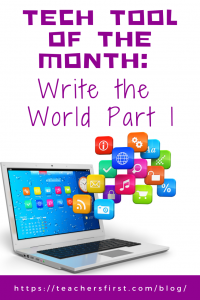Write the World is an online space for students over 13 to practice writing, earn badges, get feedback, find writing prompts, create and join public or private groups, and more. Students from over 120 countries participate in Write the World. All site users can also create a portfolio to store their writing projects. The site has two main features: monthly writing competitions (with cash prices) and private writing communities. There is also the option to share work publicly for peer review (and to review others’ writing). The writing communities are private writing groups that educators can create to allow their students to build community, assign class assignments, and have students complete peer reviews, all within the safety bubble of your private group. No one can see the writing except the students in your private group.
Applying the Triple E Framework
The Triple E Framework, created by Dr. Liz Kolb, believes that “effective technology integration begins with good instructional strategies and not fancy tools” (tripleeframework.com). Dr. Kolb wrote a book on the topic, Learning First, Technology Second (ISTE, 2017), that lays out the three main uses for technology in education: to Engage, Enhance, or Extend learning goals. We can use this framework to decipher why we use specific classroom tools. Here is a rubric based on the Triple E Framework you can use to evaluate whether Write the World (or any other technology) is a good fit with your learning goals and whether you should use it in your lesson.
- Engage in learning goals: The students are more focused on the task because they participate in writing competitions and review their peer’s writing. They are also more engaged and motivated by earning badges. The badges offer minor gamification that is not overly distracting to the students or the learning process. The students are active social learners as they write and review others’ writing. The students are motivated to begin the learning process as the competition makes the writing more fun and engaging.
- Enhance learning goals: Write the World aids students in demonstrating a more sophisticated understanding of the content and writing and focuses on the creation and production of the stories rather than the consumption of information. Students also can use Write the World to create a path to demonstrate their understanding in a way that they could not do without technology (such as earning badges, reviewing peer writing digitally, and sharing their writing with people from around the world through the contents).
- Extend learning goals: Dr. Kolb describes extended learning as an opportunity for students to learn, connect, and collaborate outside the regular school day and bridge the school day and real-life experiences. The writing competitions and assignments on Write the World could be completed as a remote, flipped, or blended learning activity. These writing assignments would make an ideal asynchronous learning experience. Independent work and writing exercises can help students build skills used in everyday lives outside of the classroom environment. Writing and communicating are a part of nearly every class and career.
SAMR Connection
The SAMR Model, by Dr. Ruben Puentedura, suggests that technology implementation has four levels. Therefore, we can use this model as a guideline to analyze how we use technology tools in the classroom. For example, the activities found at Write the World can be at the Substitution, Augmentation, Modification, and Redefinition levels, depending on what the student is doing.
- Substitution: The substitution level is the most basic level of SAMR and refers to when technology acts as a direct substitute without any functional improvements. An easy example could be students using Write the World to write a story rather than writing it on paper and stapling the pages together.
- Augmentation: At the level of augmentation, the technology acts as a direct substitute and includes some functional improvements. We could take our Write the World story to the level of augmentation by having students share their stories with their teachers using private group submission options.
- Modification: The level of modification allows us to make (or modify) the activity into something more integrated with technology, meaning there is significant task redesign. Using the same writing assignment, we could use Write the World and move to the level of modification by having students share their projects with classmates in the private group or by having students share their writing with the public through entering a writing content.
- Redefinition: At the highest level, the technology allows for creating new, previously inconceivable tasks. Returning to the example of Write the World writing assignments, we could get to the redefinition level by having students share their writing within their private group and allowing students an opportunity to write peer reviews about other students’ work.
Don’t miss Part 2 of the Tech Tool of the Month: Write the World, where we’ll discuss using the tool and classroom ideas. In the meantime, let us know how you have used Write the World in your education setting in the comment section below.


